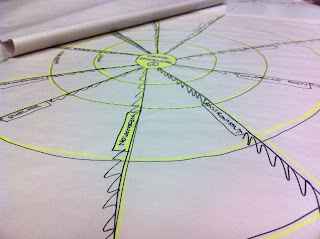Monday, 27 August 2012
Thursday, 23 August 2012
Wednesday, 22 August 2012
Monday, 13 August 2012
Week 4 Reading - Architectural Weaponry BLDG BLOG
I found this interview to be very interesting in that it talked about that
in order to move forward in the world of architecture and designing, we need to
not only be nurturing new ideas but producing them. By creating discussions
amongst architects who work closely together we are not forcing or agitating new
ideas to be realized.
I have never thought that deeply into the evolution of architecture being a slow one, but after the reading this article and reflecting back on what I know about how architecture has evolved in recent times I have come to agree with this statement. Although there are constantly new ideas about how to produce architecture such as sustainability, the rate at which they grow seems to be constrained.
Maybe this is due to tradition holding us back, governing bodies and laws restraining our freedom as creators, or maybe it is the architects fault themselves for not using their skills to their full potential and convincing the client without much persuasion that there are more exciting and advantageous design solutions to be achieved.
I have never thought that deeply into the evolution of architecture being a slow one, but after the reading this article and reflecting back on what I know about how architecture has evolved in recent times I have come to agree with this statement. Although there are constantly new ideas about how to produce architecture such as sustainability, the rate at which they grow seems to be constrained.
Maybe this is due to tradition holding us back, governing bodies and laws restraining our freedom as creators, or maybe it is the architects fault themselves for not using their skills to their full potential and convincing the client without much persuasion that there are more exciting and advantageous design solutions to be achieved.
Wednesday, 8 August 2012
Week 3 Reading - The Aspatial City
An aspatial city from my understanding is the concept that through advancements and popularity in the use of networking and data sharing websites is that there are new layers and dimensions to our cities and lives. The experience of a people and places not only exists in the physical realm but also in a virtual reality realm that I believe will only continue to grow and develop. Thinking futuristically our lives might begin to be more focused on this idea that we live in two cities, our virtual lives becoming more evolved in that we are not only sharing videos and photos etc but daily life duties such as work and study through this mode.
Monday, 6 August 2012
Week 2 - Social and Cultural Charette
During this weeks tutorial we had to come up with some ideas relating to the topics of urban, suburban, regional and virtual. The groups idea for urban was directly related to the concept of what if there were no cars aloud to enter the city centre anymore, what would happen to the existing roads and car park spaces. We came up with the idea that there would need to be a lot more train lines and tram lines put in place to carry in products as well as humans. As well as this lots of the roads would be transformed into pedestrian friendly spaces and green spaces. The existing car parks we thought could be used as water tanks as well as underwater train stations.
The second idea which stood out to me as a complete different way of living and thinking was the related to the topic of suburban. we looked at what the experience of shopping would be like if it was all done virtually. The group came up with the idea that instead of completely wiping out the shopping experience and having no one leave their homes that they would instead go to large warehouses. In these warehouses would be numerous transparent pods that customers could sit in while still being able to see other shoppers they could choose anything they needed on the screens in front of them.
Thinking about these concepts, makes me think about how much the architecture and urban fabric of cities would change. The social impacts these new ways of living would have on society and the costs involved. Also as to whether or not these changes would be beneficial in the long run.
Thursday, 2 August 2012
Week 2 Reading - Tsunami Warnings, Written in Stone
This reading talks about ancient tsunami warning stones that are strewn across the Japanese coastline, some dating as far back as six centuries ago. Some of these stones are an indicator of the water level of previous floods while others are reminders of how many lives were taken.
Some coastal towns followed the stones indications and built there houses above where they stood, while others wanted to be closer to their fishing boats believing that modern barriers and tsunami walls would protect them. This was in fact not the case and these walls were turned to rumble as soon as the tsunami waves came crashing down upon them, leaving the towns defenseless and killing a lot of the inhabitants.
I found it interesting that these ancient symbols were more reliable than modern technologies but dismissed by many of the people to be no more than ancient artefacts. This sparks thoughts as to what would be a better way to educate and warn the Japanese people of the great danger of these natural disasters. To transform the importance of the Tsunami stones into a more appropriate symbol or device that can harness the abilities of modern technology to educate and inform locals.
Subscribe to:
Comments (Atom)


